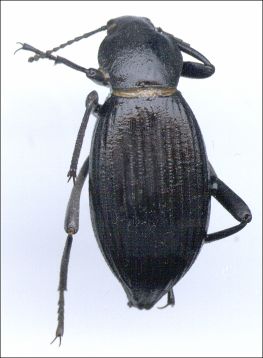
Pinacate beetles are well known to people who make a habit of wandering through our desert. These insects are seen frequently, and their relatively large size and black coloration quickly draw attention. The name comes from the Aztecs who, with commendable clarity, called them pinacatl, which means "black beetle".
You might wonder why a juicy beetle would wander around out in the
open, seemingly perfect prey for predators. Perhaps another common name might give you
a clue: stinkbug. Threaten one, and it'll lower its head and raise its rear end. Be
careful—its hinder parts are armed. An oily and highly odoriferous substance may
spread over the posterior end or, in some species, a spray of the same stuff may travel
over 10 inches. And, it doesn't wash off! Pretty well protected, right? From most
predators, yes, but there's always a few who'll find a way around any
protection. One of these is the Grasshopper Mouse, who jams the beetle—rear end
first—into the sand and proceeds to munch happily away from the front end.

Contributor: Arthur H. Harris, Laboratory for Environmental Biology, Centennial Museum, University of Texas at El Paso.
Desert Diary is a joint production of the Centennial Museum and KTEP National Public Radio at the University of Texas at El Paso.

One of the pinacate group of beetles. Image scanned from a preserved specimen.